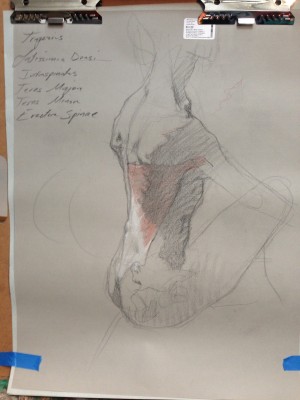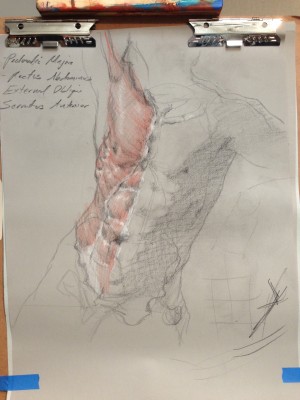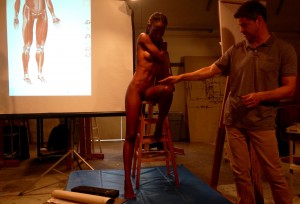
Italian Renaissance artists became anatomists by necessity. They were attempting to refine a more lifelike human figure, even though opportunities to help their knowledge by direct anatomical dissection were restricted. In Vasari’s Lives of the Artists, he states that the sculptor, painter, and printmaker Antonio Pollaiuolo (1431–1498) was the “first master to skin many human bodies in order to investigate the muscles and understand the nude in a more modern way.” We can see his knowledge displayed beautifully in Pollaiuolo’s engraving Battle of Naked Men. The nude warriors are in extreme action showing their nearly flayed musculature.
 After learning how to draw to a competent standard, I feel that some knowledge of anatomy becomes important for any artist interested in representing the body in a realistic way. So, just as the Italian Renaissance artists craved this understanding through study of anatomy, so do I. Today, however, we do not need to sharpen our knives and flay flesh to understand what lies beneath. We can enrol in a Robert Liberace workshop instead. It is far less messy and it is even legal.
After learning how to draw to a competent standard, I feel that some knowledge of anatomy becomes important for any artist interested in representing the body in a realistic way. So, just as the Italian Renaissance artists craved this understanding through study of anatomy, so do I. Today, however, we do not need to sharpen our knives and flay flesh to understand what lies beneath. We can enrol in a Robert Liberace workshop instead. It is far less messy and it is even legal.
I took a five day workshop at The Art League, Alexandria, VA entitled: Dissecting The Figure: An Anatomical Approach To Drawing and Painting. The class involved the development of the portrait and figure through comprehensive anatomical exploration. The morning session featured ecorche drawing, which highlights the specific relationships of muscle to bone, and to the external appearance of the body. See Robert’s beautiful study of the Latissimus Dorsi muscle of the amazing model, Gazelle, presented here, and his study of James, our other fabulous model, below. The afternoon session featured longer poses allowing us to use the knowledge gained in the morning to help analyse the anatomy of the figure in our drawings or paintings.
Robert also introduced us to a software programme called Visible Body: Muscle Premium. It offers finger tip control over 600 muscles and 200 bones of the body, including the ligaments. It is a wonderful, if slightly addictive, programme. Pollaiuolo would have been amazed! This programme was projected onto the screen behind the model so you could follow what was being explained. Some people had also downloaded it on to their iPad or phones. It is a wonderful teaching aid, although I was annoyed to find out that it is not written for use on a computer, just phones and iPads.
Roberts knowledge of the position, actions and names of the bones and muscles, their ligaments and their origins and insertions points on the body is astonishing. Not only that, he is an enthusiastic, passionate teacher who shares this knowledge with open generosity and spirit. You can sense this passion in his work. For more information of his workshops, or to see more of his work, look at his website.


Della, what a great opportunity, working with Rob Liberace. IMHO, he ranks right up there with all-time greats like Raphael, Ingres, and the like. Hope to take one of his workshops sometime, too. A friend recently modeled for his workshop at Whidbey Island, WA. I’d love to do that sometime, too.
He is a great teacher Scott. I recommend his workshops. He is deeply knowledgable about the body, but more importantly, he wants to transfer this knowledge to others, and so he is successful at doing so.